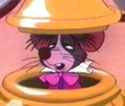|
© Copyright Nesthole 2007
|

|

|
 Newspaper
>>
The bourgeois
>>
Militant Mouse
Newspaper
>>
The bourgeois
>>
Militant Mouse
|
 Newspaper
>>
The bourgeois
>>
Militant Mouse
Newspaper
>>
The bourgeois
>>
Militant Mouse
|


This essay will look at the way in which woodland creatures have been portrayed in narratives of woodland mammals in 20th century literature. By critically analysing such works like Watership Down, Farthing Wood, we hope to demonstrate that woodland animals have traditionally been portrayed as irrational, timid creatures by an unsympathetic owligarchy. Equally, this essay proposes a brief look at alternative narrative accounts of woodland creatures that contest the owligarchical food chain hierarchy.

In the novel ‘Watership Down,’ by the non-mouse author, Richard Adams, the fragmentation of the rabbits’ habitat is vividly predicted by the rabbit ‘Fiver’, in a series of quasi-psychic visions. The issue here is the way in which rabbits attainment of knowledge occurs. The way in which they learn of the imminent destruction is profoundly irrational; half of the rabbit group sensibly refuse to listen to these visions. Their punishment is to be brutally bulldozed. Fiver is comparable to Cassandra, a doomed figure helplessly bewailing the fate of the rabbits as the Greek armies assail the walls of Ilium. Throughout the novel, Fiver is portrayed as a sensisitive, pathetic character. His only usefulness to the rabbits is as a seer, as a member of the rabbit clan, as a huntergatherer of carrots, fighter, he barely features. The implications are clear. Successful woodland creatures are those who follow the irrational. Here we see evidence, common in non-animal accounts of woodland activity, of the idea that woodland creatures have some ‘special relationship’ with nature. Where are the woodland scientists? The woodand politicians? These of course are silent. These texts have been lost simply because people do not want to read about empowered woodland creatures.

I have applied these findings to a study of the way dormouse are portrayed in popular literature and information. Perhaps the most famous representation of dormice is in Lewis Carroll’s Alice in Wonderland. The first clue as to the dormouse’s character is to be ascertained by the fact that he is a guest of a ‘mad hatter.’ The other guest is an apparently insane march hare, which is indicative of late Victorian attitudes towards woodland animals. Part of this comes from the woodland itself. In Carroll’s writing, the woodland is home to various absurd and frightening creatures, the storm crow, the Cheshire cat. It is a place that occupies the liminals of sanity. To be having a tea party on the periphery of the woodland, at the mad hatter’s cottage, is clearly the pinnacle of Carroll’s representation of the absurd. Having set the scene, we now turn to the dormouse. The dormouse is intoxicated, not with narcotics or alcohol, but sleep. This crucial part of dormouse life, this integral part of Dormouse identity, is compared to overindulgence in illicit substances by a disapproving Victorian account. The dormouse is consequently only permitted to ramble incoherently about treacle wells.
I will now turn to sleep and explain the significant and empowering role that sleep plays in dormouse subculture. Yes, sleepytime as it is called….sleepytime….sleep…squeeezzzzzzzz
For the inspiration behind this paper, Dr. Mouse is indebted to Dr. Germaine Greer’s groundbreaking examination of ‘The Tale of Two Bad Mice.’